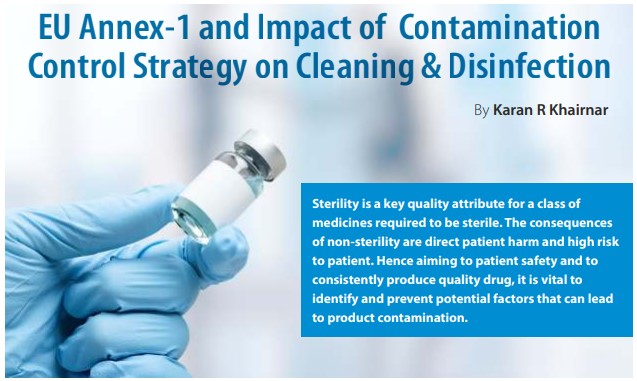
The Contamination Control Strategy (CCS) approach will continuously identify, scientifically evaluate, and effectively control potential contamination risks to product quality. To assess the risks of non-sterility a contamination control strategy is prerequisite of process and system. This will include an assessment, acknowledgement, and remediation process for contamination risks from potential extraneous sources of endotoxin/pyrogen, particulate and microbial contamination such as personnel, materials, and the surrounding environment, and assist in the rapid detection of potential contaminants in the environment and the product.
For pharmaceutical manufacturers and their suppliers, contamination of any kind that leads to product or production losses represents a significant risk. As recent events in the past, such as foreign particulate contamination (https://www.fiercepharma.com/pharma/contaminant-moderna-covid-19-vaccine-vialsfound-japan-was-metallic-particles-report), have shown, this can lead to supply bottlenecks for individual medicinal products or groups of medicinal products. Manufacturers should design their production facilities, equipment, and processes and implement Quality Risk Management (QRM) to ensure appropriate contamination control to minimize or detect contamination. (2) A holistic view is proposed in revised EU Annex 1 Aug_2022 for particulates, microbial, and pyrogen contamination.
Impact of CCS on Cleaning & Disinfection
The recent revised EU-Annex-1 elaborates various updated expectations on cleanroom cleaning, disinfection, and decontamination. Before moving ahead, let us know the expectations defined in EudraLex Volume 4, Annex-1, Aug-2022.
- CCS is key principle area in order to minimize risks of microbial, particulate and endotoxin/pyrogen contamination for the manufacturer of sterile products (Section 2.3)
- Cleanroom Cleaning & Disinfection is key element as a part of CCS (Section 2.5).
- Prior cleaning is key step of program to remove surface contamination.
- Disinfectant Validation is key stage of program
Cleaning: A process for removing contamination, e.g., product residues or disinfectant residues.
- Disinfection: The process by which the reduction of the number of microorganisms is achieved by the irreversible action of a product on their structure or metabolism, to a level deemed to be appropriate for a defined purpose.
- Decontamination: The overall process of removal or reduction of any contaminants (chemical, waste, residue or microorganisms) from an area, object, or person. The method of decontamination used (e.g. cleaning, disinfection, sterilisation) should be chosen and validated to achieve a level of cleanliness appropriate to the intended use of the item decontaminated.
The 4 major considerations from the EudraLex Vol-4 Annex-1
Contamination Control Strategy (CCS) – Key Principle Area
• The combined strategy of the CCS should establish robust assurance of contamination prevention.
• Contamination control and steps taken to minimize the risk of contamination from microbial, endotoxin/pyrogen and particle sources includes a series of inter-related events and measures.
• Potential sources of contamination are attributable to microbial and cellular debris (e.g. pyrogen, endotoxin) as well as particulate (e.g. glass and other visible and sub-visible particles).
Cleanroom Cleaning and Disinfection – key element of CCS
As specified in various sections 2.5 (xiii), 4.6, 4.33, 4.7, 4.12, 8.47 & 8.49 cleaning and disinfections are described as key element of CCS with following considerations:
- Need of appropriate risk assessment and mitigation measures should include a specific disinfection program/decontamination strategy.
- The movement of material or equipment from lower grade or unclassified area to higher-grade clean areas should be subject to cleaning and disinfection.
- The disinfection of cleanrooms is particularly important.
- Disinfectants and detergents used in grade A and grade B areas should be sterile prior to use.
- Disinfectants used in grade C and D may also be required to be sterile where determined in the CCS.
- Sufficient concentration for specified contact time to destroy bacterial and fungal spores.
Cleaning before disinfection – key step of cleaning and disinfection program
As specified in various sections 2.5 (xiii), 4.6, 4.33, 5.4, cleaning is described as key step of CCS with following considerations:
- The cleaning process prior to the bio-decontamination step is essential.
- Prior cleaning to remove surface contamination should be performed.
- Cleaning programmes should effectively remove disinfectant residues.
- The cleaning process should be validated:
-to remove any residue or debris that would detrimentally impact the effectiveness of the disinfecting agent used.
– to minimize chemical, microbial and particulate contamination of the product during the process and prior to disinfection.
Disinfectant Efficacy Validation – key focus stage of program
As specified in section 4.34, “the disinfection process should be validated”, which should include now,
- Comprehensive validation studies
- Empirical demonstration of suitability and effectiveness of disinfectants in specific manner in which they will be used.
- Shall support in-use expiry for prepared solutions
References:
- European Commission – EudraLex Volume 4, Annex-1, Manufacturing of Sterile Medicinal Products, August_2022
- How to Develop and Document a Contamination Control Strategy, A guidance document by the ECA Foundation Version 1.0; January 2022
 The author of this article, Karan R Khairnar is Global Technical Consultant Manager – Life Sciences, ECOLAB
The author of this article, Karan R Khairnar is Global Technical Consultant Manager – Life Sciences, ECOLAB














